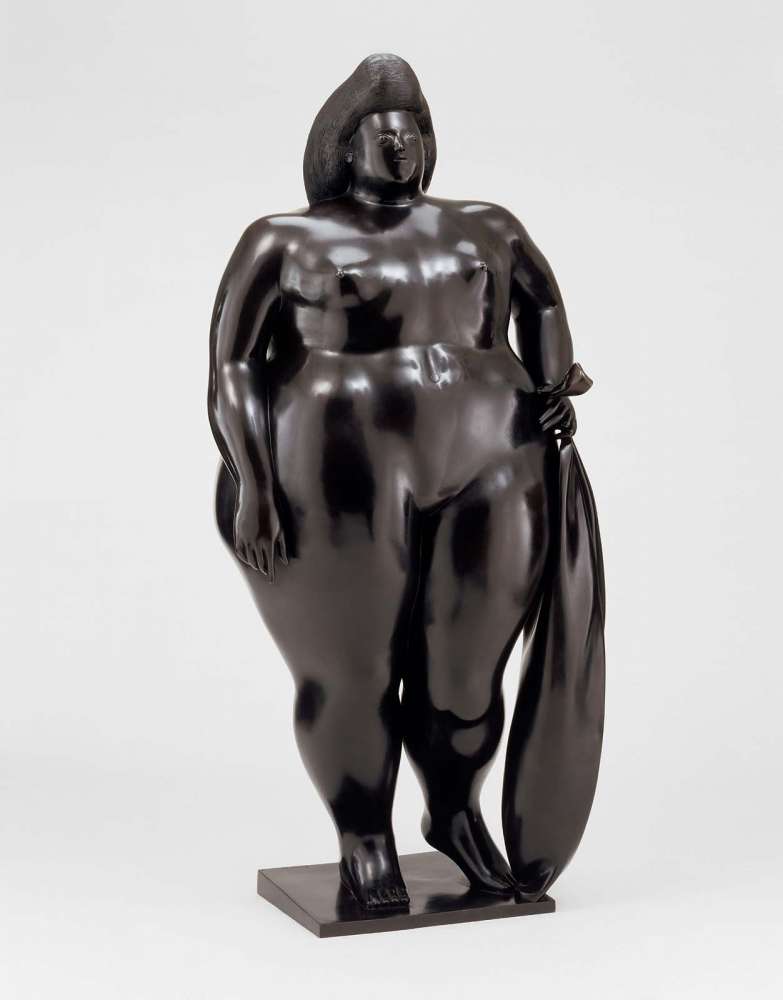13: Dear Venus
With so many different depictions over the course of history, we are left to wonder: What makes a Venus a Venus?
Venus, Fernando Botero, 1977, Museum of Fine Arts Boston, 2003.50
Welcome to Accession. Today, we're at the Museum of Fine Arts in Boston. Find the main cortyard with the giant green plant made of glass, and beyond that you'll find the central stair case for the American wing. Head up to the fourth floor and work your way through the gallery, back and to the right, past the O'Keefe's and Picasso's and Pollocks, all the way back until you find a room in Brooklyn, with a woman facing windows that don't reallyseem to be there. To your right will be a glass door that leads to some offices straight on, but once you've gone through the glass door, on you left will be a gorgeous view of Boston, with a woman standing in front of a window that is really there. Today, we're looking at Boston MFA Accession number 2003.50: Fernando Botero's Venus.
Dear Venus,
I have to admit that when I first saw you, I didn’t really recognize you. Even up close. Centuries engrained into the Western cultural consciousness, and these two decades engrained into mine have trained me not to think of a woman like you when I here the name Venus. This is a cultural bias that, try though I might to irracicate, occasionally comes to bare as I walk around museums.
Your sister from Milo tends to hog the spotlight, and define what most folks understand a Venus to look like. Of course, I should have seen the resemblance you bear to your cousin from Wilendorf, though I realize she only later got the family name, despite being the oldest among you. Still, there are definitely differences between you and your cousin.
Venus of Willendorf, 30,000 BCE, Found in Austria, Naturhistorisches Museum in Austria
Venus de Milo, Greek, 130-100 BCE, Musée du Louvre
In fact many of your physical features you actually get from your fathers side: Boteroism, as it’s called. The small sliver that is your lips. The wide almonds in almonds that are your eyes. Hair that sits up to high and then doesn't seem to fall like hair. In fact, it looks much more like a tropical fruit or a gourd placed high upon your head more than it does like hair. And of course, this is all to say nothing of the fact that you are...
I have to put a word in here. There are so many that I could use and the modern parlance is shifting so rapidly. If I was writing this letter just a year ago I might have said curvy. A few years before that rotund. At some point maybe I would have just said "larger woman" with the air quotes. Truth be told, art historians better than I have danced around your shape and hidden behind the word Boteroism to avoid putting too fine a point on it. But I'm going to take a stand. This is not the reason I am writing you a letter, and we have to move beyond it. With all the love and kindness, and genuinely, without any air of derision: Venus, you are fat.
But of course, this all begs the question, the question that has been on my mind the whole day as I walked around the MFA and have run into so many statues and paintings that share your name: what is it that makes a Venus a Venus?
Your name began as a whisper on the lips of a young Roman priest, who needed a name for the mother of the man who founded the lineage that founded the city. An of course, that mother must have been a goddess, a protector of all things loving and caring and maternal. Its hard to imagine that for so long, you were just a part of this small group of people, not even a nation or a state. Just a city, who worshiped you and made up customs and rituals and tributes specific to your role as their mother.
Venus (The Venus of Capua), Roman, A.D. 117–138, Museo Archeologico Nazionale di Napoli.
Venus over the Great Sand Dunes in Colorado, 2018, National Parks Service, Patrick Meyers
And all the while they saw the brightest star in the sky, which either rose early in the morning or was the first to be seen in the evening, depending on the time of year, and they knew... well the knew it wasn’t you. But they could look up at that brightest of stars and think of you, and think of the city you paved the way for, for them to have, and be thankful.
Time passed, as time does. Borders expanded, as borders do. And along the way you passed from one culture to another, expanding to include more and more deities and identities. Among these was of course the Greek Aphrodite, with her lust for love, her sensual pleasure, her desire, and of course her birth. The story goes that, in killing his father, Zeus castrated him, and threw his remains in the ocean. The ocean began to foam and bubble, and from that sea foam emerged you; beauty. And so this image became central to the idea of you, the emergence from the ocean, as you emerged not just as a god worshiped by the people of one town, but a central element of what historians would eventually call ancient Western culture.
And then nothing. Silence for almost a thousand years. You were usurped by a different kind of god, who represented a different kind of love, or at least, a different kind of love than the love you had transformed into. I can imagine it might have hurt to have been so loved and worshiped for so long and then to have been silenced. But there were still some. Still those who held your name as a whisper on their lips. And perhaps it was refreshing. Perhaps it is even better to be loved so much by so few, than it is to be loved so little by so many.
Of course, we’re all familiar with the story. You would emerge again, as the cultural consciousness became consumed with the idea of the classical, the antiquities, the rebirth. This time not upon the lips of the priests but in the hands of the artists. I don’t know if the transference of your worship from priests to painter changed the nature of your divinity, but this is where some of your most famous depictions would emerge, like the painting of you on the seashell, being blown by Zephyr and Aura into the arms of a nymph, the Hour of Spring. As this transference happened, you became something more than a meditation, more than a thought upon the glance at a brightest star, more than a reflection on the nature of love and lust. You became an icon, a symbol.
The Birth of Venus, Sandro Botticelli, 1480, Uffizi Gellery
But icons expand faster than borders or gods, and over the past centuries the meaning of your image has been changed and redefined so many times that archaeologists would put the name Venus on any female figure they found, even if, like your sister from Milo, it was actually an sculpture of your cousin, Aphrodite. Even if, like your cousin from Willendorf, it was sculpted long before your were even an idea, let alone a whisper.
More and more artists would call their creations Venus, even if it wasn't truly a depiction of the goddess, even if it was just a sculpture of a woman that they thought was beautiful.
And of course, somewhere along the line, in 1977 to be exact, an artist from Columbia, who worked primarily in painting, decided to make you, exactly as you stand before me today, small lips, almond eyes, hair that doesn't fall like hair, fat, and most inscrutably a Venus.
Venus, Fernando Botero, 1977, Museum of Fine Arts Boston, 2003.50
I noticed that your weight is all on one foot, and your other one is lifted, as if you are taking a step forward, and in your right hand you hold onto a towel. Perhaps you have just emerged from the shower, stepping out from the mist and steam, like beauty born from the foam of the sea.
You are one of 564 items in the MFA collection that bear the name Venus, one of 34 on display today. (Not including all the Aphrodite’s, of course.)
But what is it that holds true? What is it that rings eternal? What can be held from mother to goddess, from whisper to prayer to song, from priest to painter to cultural consciousness, from a fertility statue from Willendorf to a nude sculpture from Milo to a painting in the Uffizzi to a fat woman in the Museum of Fine Arts? Inside each is a glow, a simple light that humanity has carried with it for all of time. It has no color in the collective conscience. Despite this light being in each person, despite the fact that we can see the light in each person, the collective could never imagine such a color. But that light has a color inside of you. It’s the color you see when you close your eyes, that glows the gentlest, most calming hue you can imagine. It might be a warm crimson red, or a soft azure blue. I have no way of knowing. But I know what it is. It is love. And it matters not at all what you look like, or how you look like, or why you look like, or whether you are thin or fat. The light, the love is inside of you, because it is you. You are Venus.
With all my light, and all my love,
T.H. Ponders
Sources:
Information on Venus, be it the goddess, the planet, or the various statues came from their respective wikipedia pages.
Music:
II. Venus: Bringer of Peace, from The Planets, by Gustav Holst, 1914
Special Thanks:
My special thanks this week goes out to Sadie Mae, who is @podgeek.sadiemae on Instagram, where she posts really good podcast recomendations and thoughts on podcasts. (And has talked about Accession a few times too!) Go over and follow her on instagram to spread the love and get lots of recomendations.
Credits:
Our theme music was performed by Mike Harmon, with recording, editing, and mixing from Casey Dawson. Our show art was made by V Silverman. This episode was produced, written, recorded, and edited by T.H. Ponders.







